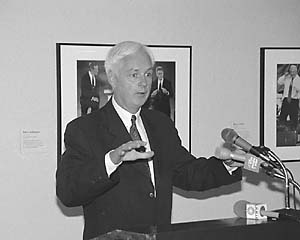
Bill Ivey speaking at Sunrise Museum
Bill Ivey, outgoing chairman of the National Endowment for the Arts, spoke July 30 at the National Assembly of State Arts Agencies and Americans for the Arts Conference in New York City. In his speech, he reviewed accomplishments from the past three years; acknowledged that he had not been able to address some issues of importance; and talked about his hopes for the future.
A success story:
Challenge America
At the top of the list of successes,
according to Ivey: " Congress has a fresh attitude toward the NEA
and our work to nurture America's living cultural heritage." In
fact, he said, the Endowment may currently be the most popular of
the federal cultural agencies in the House of Representatives. He
attributed this turnaround to several factors:
Summing up the first part of his address, Ivey said, "So, we crafted a clear message, ground in a plan. A plan dedicated to citizen service. A plan that promised results. And it worked. The NEA today is moving ahead."
Opportunities for
improvement
"We have done a good job with the
refined European arts forms," Ivey said, specifically mentioning
painting, orchestral music and ballet. He also cited folk and
traditional arts, jazz and some musical theater as strong NEA
programs. "But," he continued, "I believe the Endowment must
connect with sectors so far little touched: The mainstream
entertainment industry, commercial book and periodical publishing,
representational visual arts devoted to landscapes, marine and
aviation subjects, or the natural environment."
 Bill Ivey speaking at Sunrise Museum |
One example of such "broad engagement" is the "Songs of the Century" project, which will begin in September. This program will connect students in 10,000 fifth-grade classrooms with the finest American vernacular music of the 20th Century. Said Ivey, "It's an important first step linking the NEA with America's popular music heritage, and with the recording industry." |
Another way in which the NEA could serve, according to Ivey, is as a clearinghouse for policy discussions surrounding intellectual property, copyright protection and fair use, technology and arts labor issues.
In the area of arts education, Ivey recognized major advances, but also listed possible improvements, including finding new and better ways of assessing learning in the arts and developing after-school programs for young people.
Another challenge, said Ivey, is that connections between art and international diplomacy are poor. He said he hoped the next chairman of the NEA would address this issue.
Ivey added, "And I believe we still have some distance to travel in cementing the notion that an investment in art and art making is a public policy asset." Other potential dangers he cited were the shift from federal funding to state block grants; the trap of nostalgia for the NEA's early days; and ever-increasing demands for accountability.
Hopes for the
future
"We can't move back." Ivey summed
up. "Building upon what we've accomplished, and acknowledging what
has been imperfectly achieved, what should we do now?
"I believe we must face the challenge of developing our big ' ask' - our large shared vision for the advancement of art, art making, creativity and living cultural heritage - our goal for advancing the arts in American society.
"The big ask can't just be about more money for the NEA of for your state and local agencies, although our shared vision may require additional support. It can't just be our needs, but must address the concerns and agendas of all our citizens."
Ivey called for "a bigger, more comprehensive, more 'real world' conversation about art and society than has been conducted in the past." In an effort to stimulate such a conversation, he continued, he has put forward an American Cultural Bill of Rights, which includes:
Ivey concluded his speech on a positive note: "I am very confident in the future of the NEA. I think adversity has made all of us strong, and . . . we have an opportunity to grow the Endowment and secure for it a permanent place in America's public policy agenda."